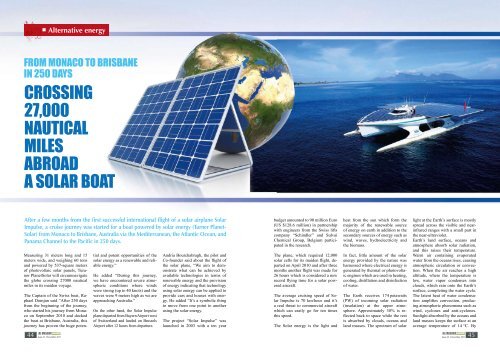Al Masdar Magazine
Al Masdar Magazine
Al Masdar Magazine
You also want an ePaper? Increase the reach of your titles
YUMPU automatically turns print PDFs into web optimized ePapers that Google loves.
<strong>Al</strong>ternative energy<br />
FROM MONACO TO BRISBANE<br />
IN 250 DAYS<br />
CROSSING<br />
27,000<br />
NAUTICAL<br />
MILES<br />
ABROAD<br />
A SOLAR BOAT<br />
After a few months from the first successful international flight of a solar airplane Solar<br />
Impulse, a cruise journey was started for a boat powered by solar energy (Turner Planet-<br />
Solar) from Monaco to Brisbane, Australia via the Mediterranean, the Atlantic Ocean, and<br />
Panama Channel to the Pacific in 250 days.<br />
Measuring 31 meters long and 15<br />
meters wide, and weighing 60 tons<br />
and powered by 537-square meters<br />
of photovoltaic solar panels, Turanor<br />
PlanetSolar will circumnavigate<br />
the globe crossing 27000 nautical<br />
miles in its maiden voyage.<br />
The Captain of the Swiss boat, Raphael<br />
Domjan said “After 250 days<br />
from the beginning of the journey,<br />
who started his journey from Monaco<br />
on September 2010 and docked<br />
the boat at Brisbane, Australia, this<br />
journey has proven the huge poten-<br />
tial and potent opportunities of the<br />
solar energy as a renewable and reliable<br />
energy.”<br />
He added “During this journey,<br />
we have encountered severe atmospheric<br />
conditions where winds<br />
were strong (up to 40 knots) and the<br />
waves were 9 meters high as we are<br />
approaching Australia.”<br />
On the other hand, the Solar Impulse<br />
plane departed from Bayern Airport west<br />
of Switzerland and landed on Brussels<br />
Airport after 12 hours from departure.<br />
Andria Bourchabragh, the pilot and<br />
Co-founder said about the flight of<br />
the solar plane, “We aim to demonstrate<br />
what can be achieved by<br />
available technologies in terms of<br />
renewable energy and the provision<br />
of energy indicating that technology<br />
using solar energy can be applied to<br />
provide cars and houses with energy.<br />
He added “It’s a symbolic thing<br />
to move from one point to another<br />
using the solar energy.<br />
The project “Solar Impulse” was<br />
launched in 2003 with a ten year<br />
budget amounted to 90 million Euro<br />
(US $128.6 million) in partnership<br />
with engineers from the Swiss lifts<br />
company “Schindler” and Sulvai<br />
Chemical Group, Belgium participated<br />
in the research.<br />
The plane, which required 12,000<br />
solar cells for its maiden flight, departed<br />
on April 2010 and after three<br />
months another flight was made for<br />
26 hours which is considered a new<br />
record flying time for a solar powered<br />
aircraft.<br />
The average cruising speed of Solar<br />
Impulse is 70 km/hour and it’s<br />
a real threat to commercial aircraft<br />
which can easily go for ten times<br />
this speed.<br />
The Solar energy is the light and<br />
heat from the sun which form the<br />
majority of the renewable source<br />
of energy on earth in addition to the<br />
secondary sources of energy such as<br />
wind, waves, hydroelectricity and<br />
the biomass.<br />
In fact, little amount of the solar<br />
energy provided by the nature was<br />
harnessed where electrical energy is<br />
generated by thermal or photovoltaic<br />
engines which are used in heating,<br />
cooling, distillation and disinfection<br />
of water.<br />
The Earth receives 174 petawatts<br />
(PW) of incoming solar radiation<br />
(insolation) at the upper atmosphere.<br />
Approximately 30% is reflected<br />
back to space while the rest<br />
is absorbed by clouds, oceans and<br />
land masses. The spectrum of solar<br />
light at the Earth’s surface is mostly<br />
spread across the visible and nearinfrared<br />
ranges with a small part in<br />
the near-ultraviolet.<br />
Earth’s land surface, oceans and<br />
atmosphere absorb solar radiation,<br />
and this raises their temperature.<br />
Warm air containing evaporated<br />
water from the oceans rises, causing<br />
atmospheric circulation or convection.<br />
When the air reaches a high<br />
altitude, where the temperature is<br />
low, water vapor condenses into<br />
clouds, which rain onto the Earth’s<br />
surface, completing the water cycle.<br />
The latent heat of water condensation<br />
amplifies convection, producing<br />
atmospheric phenomena such as<br />
wind, cyclones and anti-cyclones.<br />
Sunlight absorbed by the oceans and<br />
land masses keeps the surface at an<br />
average temperature of 14 °C. By<br />
44 Issue 42 - December 2011 45<br />
Issue 42 - December 2011











